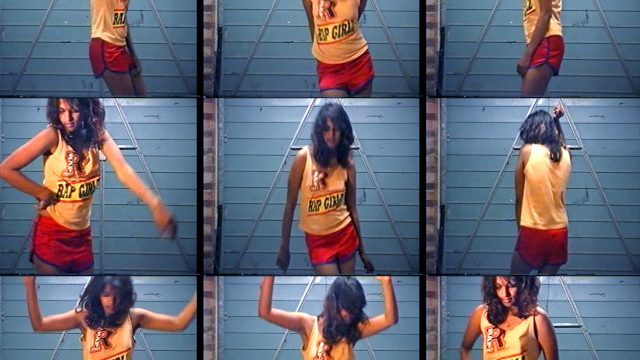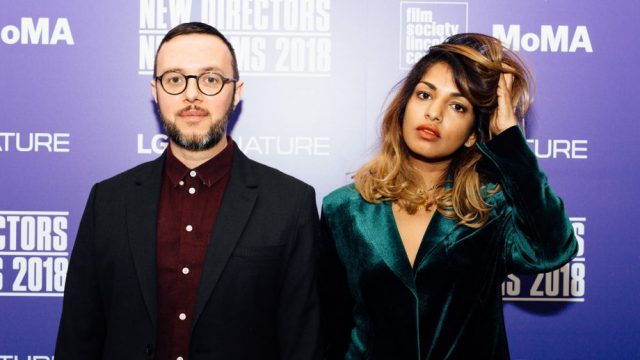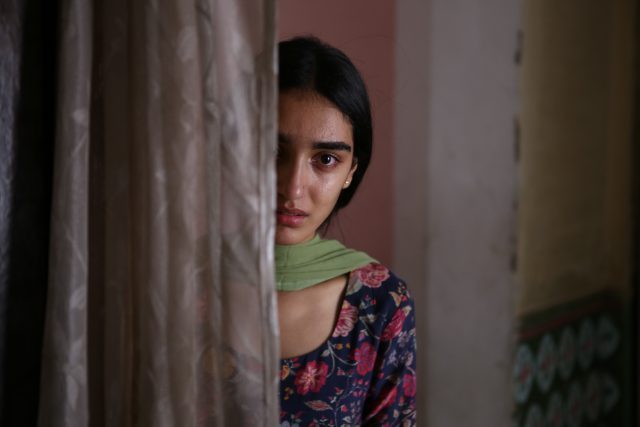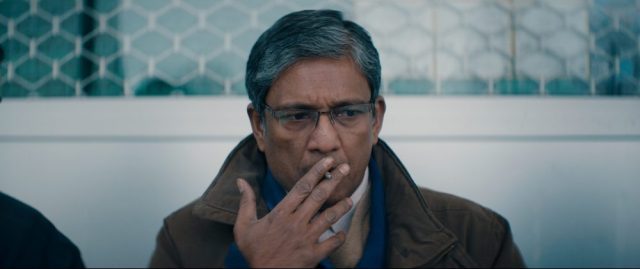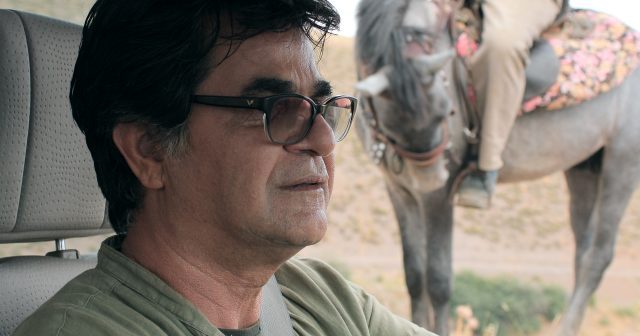
Iranian auteur Jafar Panahi plays himself in gorgeously photographed and beautifully paced 3 Faces
3 FACES (SE ROKH) (Jafar Panahi, 2018)
IFC Center
323 Sixth Ave. at West Third St.
Sunday, January 13, 7:15
Series runs January 10-15
212-924-7771
www.ifccenter.com
www.irfilmfestny.com
 One of the most brilliant and revered storytellers in the world, Iranian auteur Jafar Panahi proves his genius yet again with his latest cinematic masterpiece, the tenderhearted yet subtly fierce road movie 3 Faces. The film, which made its US premiere this past fall at the New York Film Festival and won the Best Screenplay prize at Cannes, is screening January 13 as part of IFC Center’s inaugural Iranian Film Festival New York. As with some of Panahi’s earlier works, 3 Faces walks the fine line between fiction and nonfiction while defending the art of filmmaking. Popular Iranian movie and television star Behnaz Jafari, playing herself, has received a video in which a teenage girl named Marziyeh (Marziyeh Rezaei), frustrated that her family will not let her study acting at the conservatory where she’s been accepted, commits suicide onscreen, disappointed that her many texts and phone calls to her hero, Jafari, went unanswered. Deeply upset by the video — which was inspired by a real event — Jafari, who claims to have received no such messages, enlists her friend and colleague, writer-director Panahi, also playing himself, to head into the treacherous mountains to try to find out more about Marziyeh and her friend Maedeh (Maedeh Erteghaei). They learn the girls are from a small village in the Turkish-speaking Azeri region in northwest Iran, and as they make their way through narrow, dangerous mountain roads, they encounter tiny, close-knit communities that still embrace old traditions and rituals and are not exactly looking to help them find out the truth.
One of the most brilliant and revered storytellers in the world, Iranian auteur Jafar Panahi proves his genius yet again with his latest cinematic masterpiece, the tenderhearted yet subtly fierce road movie 3 Faces. The film, which made its US premiere this past fall at the New York Film Festival and won the Best Screenplay prize at Cannes, is screening January 13 as part of IFC Center’s inaugural Iranian Film Festival New York. As with some of Panahi’s earlier works, 3 Faces walks the fine line between fiction and nonfiction while defending the art of filmmaking. Popular Iranian movie and television star Behnaz Jafari, playing herself, has received a video in which a teenage girl named Marziyeh (Marziyeh Rezaei), frustrated that her family will not let her study acting at the conservatory where she’s been accepted, commits suicide onscreen, disappointed that her many texts and phone calls to her hero, Jafari, went unanswered. Deeply upset by the video — which was inspired by a real event — Jafari, who claims to have received no such messages, enlists her friend and colleague, writer-director Panahi, also playing himself, to head into the treacherous mountains to try to find out more about Marziyeh and her friend Maedeh (Maedeh Erteghaei). They learn the girls are from a small village in the Turkish-speaking Azeri region in northwest Iran, and as they make their way through narrow, dangerous mountain roads, they encounter tiny, close-knit communities that still embrace old traditions and rituals and are not exactly looking to help them find out the truth.
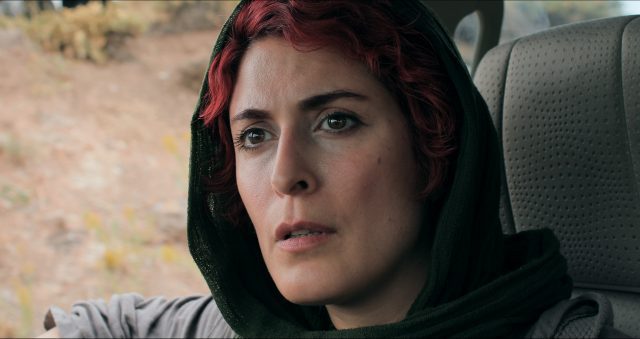
Iranian star Behnaz Jafari plays herself as she tries to solve a mystery in Jafar Panahi’s 3 Faces
Panahi (Offside, The Circle) — who is banned from writing and directing films in his native Iran, is not allowed to give interviews, and cannot leave the country — spends much of the time in his car, which not only works as a plot device but also was considered necessary in order for him to hide from local authorities who might turn him in to the government. He and Jafari stop in three villages, the birthplaces of his mother, father, and grandparents, for further safety. The title refers to three generations of women in Iranian cinema: Marziyeh, the young, aspiring artist; Jafari, the current star (coincidentally, when she goes to a café, the men inside are watching an episode from her television series); and Shahrzad, aka Kobra Saeedi, a late 1960s, early 1970s film icon who has essentially vanished from public view following the Islamic Revolution of 1978-79, banned from acting in Iran. (Although Shahrzad does not appear as herself in the film, she does read her poetry in voiceover.) 3 Faces is gorgeously photographed by Amin Jafari and beautifully edited by Mastaneh Mohajer, composed of many long takes with few cuts and little camera movement; early on there is a spectacular eleven-minute scene in which an emotionally tortured Behnaz Jafari listens to Panahi next to her on the phone, gets out of the car, and walks around it, the camera glued to her the whole time in a riveting tour-de-force performance.
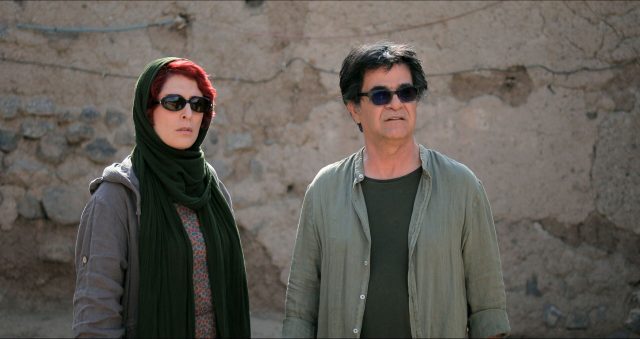
Behnaz Jafari and Jafar Panahi encounter culture clashes and more in unique and unusual road movie
3 Faces is Panahi’s fourth film since he was arrested and convicted in 2010 for “colluding with the intention to commit crimes against the country’s national security and propaganda against the Islamic Republic”; the other works are This Is Not a Film, Closed Curtain, and Taxi Tehran, all of which Panahi starred in and all of which take place primarily inside either a home or a vehicle. 3 Faces is the first one in which he spends at least some time outside, where it is more risky for him; in fact, whenever he leaves the car in 3 Faces, it is evident how tentative he is, especially when confronted by an angry man. The film also has a clear feminist bent, not only centering on the three generations of women, but also demonstrating the outdated notions of male dominance, as depicted by a stud bull with “golden balls” and one villager’s belief in the mystical power of circumcised foreskin and how he relates it to former macho star Behrouz Vossoughi, who appeared with Shahrzad in the 1973 film The Hateful Wolf and is still active today, living in California. Panahi, of course, will not be present at the IFC screening, as his road has been blocked, leaving him a perilous path that he must navigate with great care. However, Iranian writer, director, and producer Bahman Farmanara will be at the festival for Q&As following three of his films, opening night’s Tale of the Sea in addition to I Want to Dance and Tall Shadows of the Wind. Cofounded and coprogrammed by Godfrey Cheshire, the first Iranian Film Festival New York includes such other classic and cutting-edge films as Asghar Yousefinejad’s The Home, Abbas Amini’s Hendi & Hormoz, and Houman Seyedi’s closing night Sheeple, in addition to a tribute to Abbas Kiarostami, who passed away in 2016 at the age of seventy-six, pairing Seifollah Samadian’s 76 Minutes and 15 Seconds with Abbas Kiarostami with Kiarostami’s 2016 short Take Me Home.
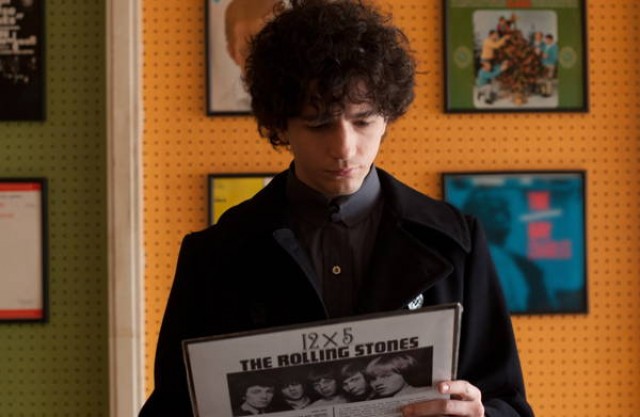
 Inspired by his brief stint as a suburban New Jersey garage-band drummer with rock-and-roll dreams, Sopranos creator David Chase made his feature-film debt with the 2012 musical coming-of-age drama Not Fade Away. Written and directed by Chase, the film focuses on Douglas (John Magaro), a suburban New Jersey high school kid obsessed with music and The Twilight Zone. It’s the early 1960s, and Douglas soon becomes transformed when he first hears the Beatles and the Stones — while also noticing how girls go for musicians, particularly Grace (Bella Heathcote), whom he has an intense crush on but who only seems to date guys in bands. When his friends Eugene (Jack Huston) and Wells (Will Brill) ask him to join their group, Douglas jumps at the chance, but it’s not until he gets the opportunity to sing lead one night that he really begins to think that music — and Grace — could be his life. Not Fade Away has all the trappings of being just another clichéd sex, drugs, and rock-and-roll movie, but Chase and musical supervisor (and executive producer) Steven “Silvio” Van Zandt circumvent genre expectations and limitations by, first and foremost, nailing the music. Van Zandt spent three months teaching the main actors how to sing, play their instruments, and, essentially, be a band, making the film feel real as the unnamed group goes from British Invasion covers to writing their own song. Even Douglas’s fights with his conservative middle-class father (James Gandolfini) and his battle with Eugene over the direction of the band are handled with an intelligence and sensitivity not usually seen in these kinds of films. Not Fade Away does make a few wrong turns along the way, but it always gets right back on track, leading to an open-ended conclusion that celebrates the power, the glory, and, ultimately, the mystery of rock and roll.
Inspired by his brief stint as a suburban New Jersey garage-band drummer with rock-and-roll dreams, Sopranos creator David Chase made his feature-film debt with the 2012 musical coming-of-age drama Not Fade Away. Written and directed by Chase, the film focuses on Douglas (John Magaro), a suburban New Jersey high school kid obsessed with music and The Twilight Zone. It’s the early 1960s, and Douglas soon becomes transformed when he first hears the Beatles and the Stones — while also noticing how girls go for musicians, particularly Grace (Bella Heathcote), whom he has an intense crush on but who only seems to date guys in bands. When his friends Eugene (Jack Huston) and Wells (Will Brill) ask him to join their group, Douglas jumps at the chance, but it’s not until he gets the opportunity to sing lead one night that he really begins to think that music — and Grace — could be his life. Not Fade Away has all the trappings of being just another clichéd sex, drugs, and rock-and-roll movie, but Chase and musical supervisor (and executive producer) Steven “Silvio” Van Zandt circumvent genre expectations and limitations by, first and foremost, nailing the music. Van Zandt spent three months teaching the main actors how to sing, play their instruments, and, essentially, be a band, making the film feel real as the unnamed group goes from British Invasion covers to writing their own song. Even Douglas’s fights with his conservative middle-class father (James Gandolfini) and his battle with Eugene over the direction of the band are handled with an intelligence and sensitivity not usually seen in these kinds of films. Not Fade Away does make a few wrong turns along the way, but it always gets right back on track, leading to an open-ended conclusion that celebrates the power, the glory, and, ultimately, the mystery of rock and roll.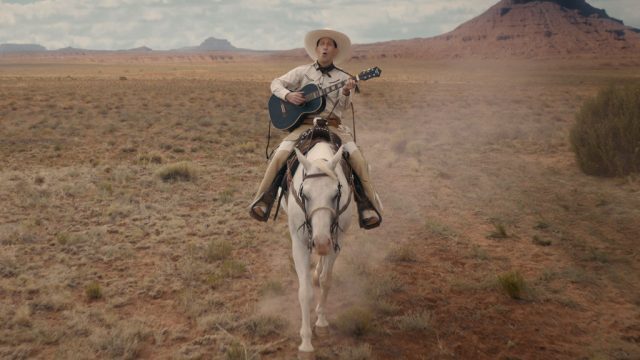
 The Coen brothers honor and subvert the Western as only they can in The Ballad of Buster Scruggs, a six-part anthology film they made for Netflix. It also was shown in two theaters for a week — making it eligible for Oscars — and is having a special screening on November 29 at the Museum of the Moving Image. Over the course of the last quarter-century, Joel and Ethan Coen wrote a handful of short movies that they thought would never get made, but they eventually decided to put them together into one omnibus film. Each segment tackles a different subgenre, involves at least one death, and begins with the turning of pages in an illustrated book, as if these are old classic Western fables, although that’s just a cinematic conceit: Only “The Gal Who Got Rattled” and “All Gold Canyon” were inspired by real works, by Stewart Edward White and Jack London, respectively.
The Coen brothers honor and subvert the Western as only they can in The Ballad of Buster Scruggs, a six-part anthology film they made for Netflix. It also was shown in two theaters for a week — making it eligible for Oscars — and is having a special screening on November 29 at the Museum of the Moving Image. Over the course of the last quarter-century, Joel and Ethan Coen wrote a handful of short movies that they thought would never get made, but they eventually decided to put them together into one omnibus film. Each segment tackles a different subgenre, involves at least one death, and begins with the turning of pages in an illustrated book, as if these are old classic Western fables, although that’s just a cinematic conceit: Only “The Gal Who Got Rattled” and “All Gold Canyon” were inspired by real works, by Stewart Edward White and Jack London, respectively.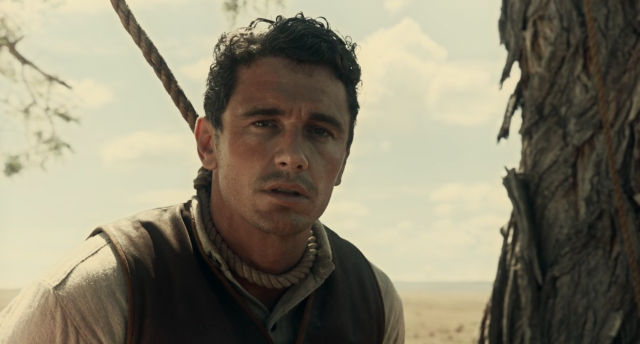
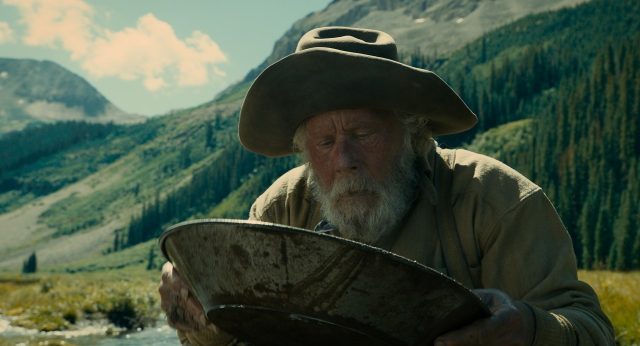
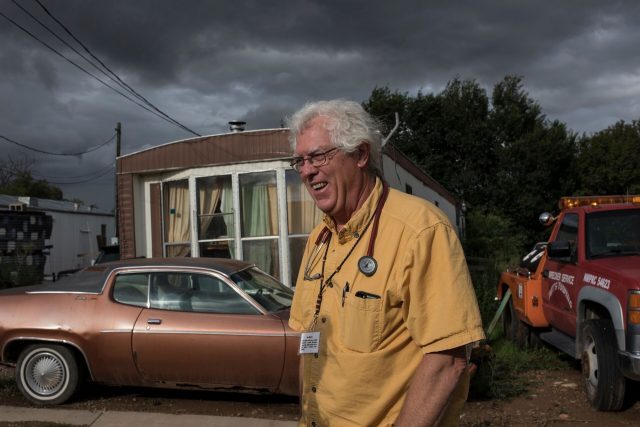
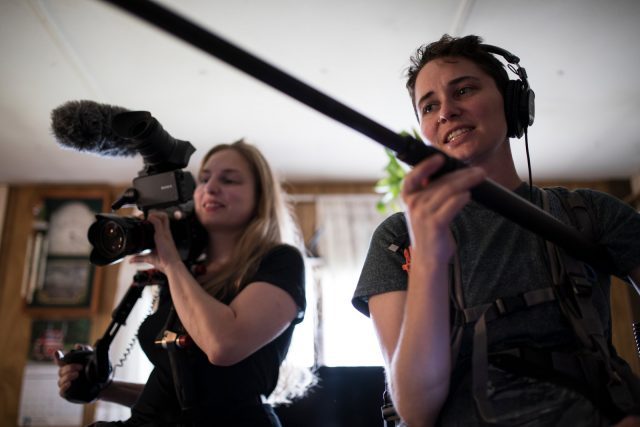

 And you thought the rat problem in New York City was bad. “I wanna tell you all a tale that’s crazier than hell,” Louisiana native and Treme star Wendell Pierce says at the beginning of Rodents of Unusual Size, Chris Metzler, Jeff Springer, and Quinn Costello’s eye-opening documentary about the nutria, the twenty-pound web-footed, orange-toothed South American creature that was introduced to Louisiana in the 1930s to boost the fur trade and has wreaked havoc ever since. The rodents multiply like tribbles and destroy so much vegetation that the resulting erosion affects storm surge protection, leading the government to encourage the mass murder of the beast by offering a five-dollar bounty for each tail. The filmmakers visit Delacroix and the Ninth Ward in New Orleans, talking to such nutria hunters as Larry Aucoin, Darrell Aucoin, Liz LeCompte, and Trey Hover, who is killing the swamp rat to help pay for his college education. LeCompte is doing it to protect the environment. “If the land’s gone, then me and my family don’t have a future,” she says, explaining that “Cajun women, they not afraid to get their hands dirty.” Nutria control specialist Michael Beran, who patrols the canal banks and uncovers nutria-built subterranean labyrinths that can also endanger bridges, notes that the nutria is an “invasive species [that] has to be deleted.” Nutria tail assessor John Siemion gets right to the point: “It offers these guys money when there is none,” he says. “This is their income for the year.”
And you thought the rat problem in New York City was bad. “I wanna tell you all a tale that’s crazier than hell,” Louisiana native and Treme star Wendell Pierce says at the beginning of Rodents of Unusual Size, Chris Metzler, Jeff Springer, and Quinn Costello’s eye-opening documentary about the nutria, the twenty-pound web-footed, orange-toothed South American creature that was introduced to Louisiana in the 1930s to boost the fur trade and has wreaked havoc ever since. The rodents multiply like tribbles and destroy so much vegetation that the resulting erosion affects storm surge protection, leading the government to encourage the mass murder of the beast by offering a five-dollar bounty for each tail. The filmmakers visit Delacroix and the Ninth Ward in New Orleans, talking to such nutria hunters as Larry Aucoin, Darrell Aucoin, Liz LeCompte, and Trey Hover, who is killing the swamp rat to help pay for his college education. LeCompte is doing it to protect the environment. “If the land’s gone, then me and my family don’t have a future,” she says, explaining that “Cajun women, they not afraid to get their hands dirty.” Nutria control specialist Michael Beran, who patrols the canal banks and uncovers nutria-built subterranean labyrinths that can also endanger bridges, notes that the nutria is an “invasive species [that] has to be deleted.” Nutria tail assessor John Siemion gets right to the point: “It offers these guys money when there is none,” he says. “This is their income for the year.”